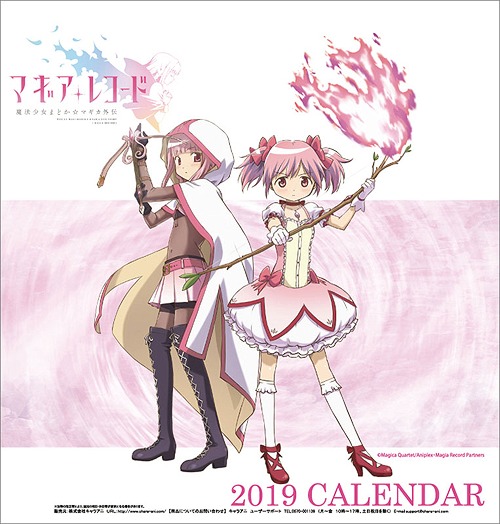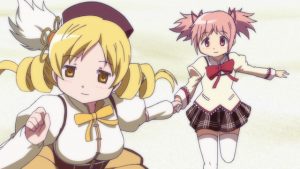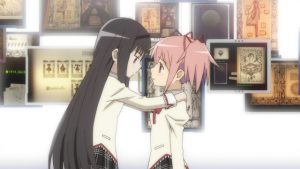
Despite the show’s title, Madoka has mostly been an observer. Watching from the sidelines, she is powerless to stop the tragedy before her. As the end approaches, Madoka must now make a decision. With her back towards Homura, we see the girl who now shoulders the world.
In this final article, I’ll discuss a logical segue. If Madoka Magica is a divided world, then a discussion of character foils is important. From that context, I’ll discuss how faith is an integral element of the show and how suffering is given meaning through hope.
Foiling Characters and Themes: Establishing Context
In literature, a foil character is a character who contrasts with another, typically the protagonist. By having several distinct and contrasting qualities, it can serve a narrative function. Not only can a character’s qualities be foiled, but so can their stories and histories.
In Madoka Magica, the main cast is designed around familiar ideas. In magical girl shows, color can be part of a character’s identity. Colors can indicate a character’s element such as red for fire or blue for water. Since magic is tied to one’s emotions, this goes a step further: it’s their personality.
Before moving onto our main topics of faith and hope, let’s briefly discuss how Kyoko and Sayaka foil one another. Kyoko, like her element, has a fiery personality. She is one of the veteran magical girls and views Mitakihara City as her new hunting ground. Initially, she comes off as brash and rude, facing resistance from the cast.
Still hurt from Mami’s death, Sayaka feels she must take up Mami’s role. To protect the city, she must become a hero. Thus, when Sayaka transforms, her design is not by chance--this is her view of justice: what a magical girl should be. She dawns a cape and sword, preferring close combat; apt due to her direct personality.
However, as we later learn, Sayaka is rigid in her beliefs, resulting in her fighting other magical girls. Water can be many things: it can flow, it can change its shape, it can be transparent, and it can be reflective. However, Sayaka does not hold all of these qualities; she’s inexperienced and does not “embody water.”
Although Kyoko and Sayaka initially clash, Kyoko does notice a similarity. While Sayaka does not self-reflect early on, she does reflect something. Kyoko sees in Sayaka the girl she used to be. Through this, we learn both characters foil one another.
Just as Sayaka lacks the qualities of water, Kyoko “lacks the fire she once had.” Kyoko was the daughter of an unorthodox priest. In order to make his teachings spread, Kyoko wishes for his message to be heard by everyone. People flock to her father and “listen to his teachings.” While Kyoko fights against witches, she’s ignorant how her wish has stolen agency from her father’s believers.
One day, Kyoko’s wish is exposed. Upon finding out, he casts Kyoko aside, believing her to be a witch. Kyoko’s story ends with her father killing his entire family, their bodies cast like fuel to a fire.
This imagery makes it clear. As the sole survivor, Kyoko blames herself. She loses faith in her cause and her father’s teachings. Instead, she learns through experience that “to help others is fruitless,” a lesson that the world is teaching the cast. Thus, she chooses to live only for herself.
She has lost the piety in her pyre--the faith and the fire.
But something changes in Kyoko. When she sees Sayaka, she can’t help but care. Even though she lives alone, she’s had a teacher--life taught her lessons. Before Sayaka hurts herself, Kyoko extends a hand. In it, a biblical fruit to “cure Sayaka’s innocence.”
Character foils help enunciate a message, establish themes, and can give direction for a character’s development. This dynamic, if brought to fruition, can help relationships grow, but in this show, growth is stunted.
Before characters are ready, they are thrown into situations where their wishes are manipulated, turning their altruism against them. For most of the show, characters are not rewarded for their faith. They die for it.
When Kyoko tries to save Sayaka, she does so without certainty. She does so based on faith. Her hopes are shattered when Sayaka transforms into a witch. In order to save Homura and Madoka, Kyoko takes her soul gem and clasps it, her hands in prayer. In her final moments, she regains faith, but she burns for it.
The “witches” die by fire.
Foiling Further: Comparisons Between Pairs
From the previous section, we know that inexperience and experience were qualities being compared. To further add to this, Sayaka dies losing faith in humanity, but Kyoko regains it after sacrificing herself. These character qualities are not exclusive to these two. They apply to another pair.
In the previous article, I explain how Homura rejects magical girl values and how camera techniques, character movement, eye imagery, and lighting allow viewers to understand and empathize with her. Through this, the article established that, although magic allows girls to better themselves and their world, magic in Madoka Magica has not changed their situation. Thus, to reiterate our last article, Homura has embodied the lessons of hopelessness. She is the antithesis of her genre.
Kyoko and Homura share something in common: experience. Their experience makes them scorn their childhood naiveté: that the world was kind, that friendship mattered, that the very ideas the magical girl want to promote--they are just lies. Dreams don’t live to see the future.
Just as Kyoko and Homura share a commonality, their counterparts do as well. Sayaka and Madoka are inexperienced. Sayaka died believing she lived a lie, but for the show to have hope, Madoka, the girl who still believes in good--who has faith in humanity and the world--can not lose that innocence.
Thus, if Homura represents hopelessness, Madoka must represent hope. If she cannot, then all the emotions they’ve felt, every wish they’ve cherished, all the suffering they’ve endured, will all be for nothing.
For a future to exist, for this generation to have hope, childhood dreams must not be squandered. The children are the future, and if they cannot dream, then their future ends in the night. For the sun to rise, there must be a light.
Homura knows the future. She has observed it countless times. For her, the problem isn’t a dark and uncertain future. It’s the opposite: certainty is the problem. Thus, if the future is predetermined, then Madoka must bring back something uncertain. Madoka must believe in something despite rational proof.
She must bring back faith in the future.
The Return of Hope: Reaffirming Faith in the World
In their innocence, the kind world the cast knew now seems like a lie. Emerging from that bliss and into reality is part of adolescence. However, adolescence is not just suffering, and childhood is not just pain.
However, many of the characters do not have anyone to teach them otherwise. This is the case for every character--except for Madoka. Unlike the other girls, her parents still take an active part in her life. Unlike the others, she exists mostly as an observer, powerless to stop her friends from “falling further.” Unlike others, even in the darkest scenes, she is blessed by a faint light that shines upon her.
Madoka is the last remaining girl who still believes in hope.
Religious imagery is everywhere in Madoka Magica. From Sayaka’s serpent-like lance to Michel Angelo’s Creation of Adam in episode 11. For context, allow a brief segue into two mindsets on meaning, of which multiple exist.
One mindset believes an object’s meaning is not necessarily within it; it’s not innate. Due to this, meaning doesn’t exist the moment something is born, but it is created through context like culture. According to this thought process, meaning is bestowed by people. We make meaning because we value something, therefore we can ascribe meaning to a relationship with a wedding ring.
Another mindset believes meaning is innate. In some religions, meaning is bestowed through a deity, and it’s through the process of creation that meaning is given. Therefore, life is given significance because it is holy. Suffering is given meaning because it’s part of a plan. A book is sacred because it contains words from God who doesn’t just create things but creates meaning.
Within the context of the show, the world does not value these girls who die--that’s the tragedy. Even if someone cares, the problem remains: it’s possible that death and suffering can amount to nothing. Humans are just cogs in a wheel meant to prolong an uncaring system. That’s the current rule of the world, and girls have died trying to change that.
For the entirety of the show, Madoka has held back on her wish. Part of that is due to the cast. After being supported by Madoka, Mami wants her to join but dies soon after. Sayaka grows jealous of Madoka, her responsibility as the city’s protector denies her a childhood (romance) she wanted.
Kyoko, having suffered her role, knows the loneliness that being a protector can bring and tells Madoka it’s foolish to enter her world on a whim. Homura, from the onset, never wanted Madoka to become a magical girl.
Despite their best efforts, Madoka isn’t truly innocent--at least in the childhood sense. She has experienced hardships so early in her life. However, it is through these hardships that she can give meaning. She constructs meaning because she values the relationships she’s formed. Her emotions, things that magical girls should value, are the context and the proof.
In the final episode, when Madoka reveals her wish, it’s not a wish devoid of experience or suffering; Madoka understands that. It’s also not a wish that is lacking innocence. Her role models have taught her its importance. She wishes a selfless wish, one that restores hope in the world.
“I wish to erase all witches before they are born. All the witches in all the universes, both past and the future… With my own hands!” Kyubey, shocked by the audacity of her wish, exclaims, “If a prayer like that were granted, it could unravel the fabric of time itself… Do you truly intend to become a god?!”
Madoka’s wish combines the innocence of her childhood with the wisdom of her experience. She has not just survived adolescence, she’s blossomed because of it. Her wish, her prayer for the world to become a better place, is the epitome of her genre. She reaffirms faith in the world, in people, in hope--she bestows meaning as a deity.
Madoka responds, “I don’t care what I become. All those who’ve fought against witches, who believed in hope as magical girls… I don’t want to see them cry. I want them to be smiling to the very end… If any rule or law stands in the way of that… I will destroy it. I will rewrite it. That is my prayer… That is my wish.”
Madoka’s wish is so selfless, she loses her body. She no longer just embodies hope. She becomes it. By valuing her friends, she learns from their suffering. From having role models, she’s become one. Madoka reflects her beliefs: magic is hope and hope is alive.
In every moment a magical girl is about to lose hope, Madoka comforts them. During these sequences, heart imagery is abound: on clothing, arm bands, and soul gems. Later, in the soul gem’s reflection, girls from a previous scenes appear. Magical girls now press their soul gem to their chest. In their hearts, they know someone cares.
Madoka has changed reality. Her wish as innocent as the rosebud on her bow; her influence as clear as the sky turned blue. As a magical girl, her power is vast and all-encompassing. Her power is no lie. To her, it was always true: love moves the world.
And love can change it anew.
Final Thoughts

Having reached the finale, I just wanted to thank everyone who read this far and supported me. Madoka Magica has been a show that deeply impacted me, and without its story, I honestly might have never studied film.
As this is the final article, I’d love to hear your thoughts on this 7-part article series. If there’s enough interest, perhaps I can cover Madoka Magica’s third movie. I look forward to the comments and hope my writing has given readers an interesting perspective on this show.




